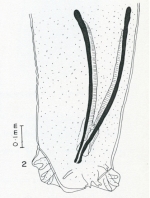NEIHPID
North-East India Helminth Parasite Information Database
Recently added
Parasites
Molecular Data
Stephanurus dentatus (Diesing Diesing)
Taxonomy
Nematoda »
SECERNENTEA »
Syngamidae Leiper, 1912 »
Stephanurinae Railliet, Henry et Bauche, 1919 »
Stephanurus Diesing, 1839 »
Stephanurus dentatus, Diesing 1839
Host
Sus (scrofa domestica)
Habitat
Renal and peritoneal tissues
Locality
Shillong (Meghalaya), Nongstoin (Meghalaya), Mairang (Meghalaya), Jowai (Meghalaya)
Description
General
Medium-sized worms, body relatively stout, curved ventrally at anterior end. Cuticle transparent, internal organs partly visible through it. Mouth circular, directed straight forwards provided with external corona radiata consisting of about 50-55 small elements; cuticle surrounding mouth reflected externally to form six thickenings- epaulettes, two median, four sub-median, dorsal and ventral thickenings most prominent. Buccal capsule well developed, cup shaped, thick walled, with six variable sized teeth at its base. Oesophagus club shaped. Intestine considerably longer than body, in convoluted form.
Male
Body length 22.0-28.0, 1.29-1.44 mm in maximum width. Bursa in degenerate form, very short, sub-terminal; bursal rays short, stout; ventral rays cleft; externo-dorsal arising separately from dorsal; dorsal divided distally into two bi-digitate limbs; lateral rays closely applied to each other; postero-lateral ray thicker than other two. Spicules equal, with transversely striated alae, slightly swollen at tips. Gubernaculum flattened, heart shaped.
Female
Body 29.0-42.0 mm in length, 1.60- 1.87 mm in maximum width, bent ventrally, almost at right angle, behind vulva. Tail short, abruptly attenuated behind anus, bearing pair of globular lateral cuticular processes. Vulva little in front of anus. Vagina very short, leading into paired uterine branches, latter opposed at first, posterior branch turning forward almost at once to run parallel with other. Eggs 0.08-0.09 x 0.05-0.06 mm in size, ellipsoidal, thin shelled.
Remarks
Only a single species viz. S. dentatus is known to represent the genus. According to Baylis (1936a) the Indian origin of the specimens recorded as S. dentatus in the collection of the Zoological Survey of India by Baylis and Daubney (1923) is doubtful as this material was supposed to have come from some other place. However, the species has been reported in domestic pigs of Madhya Pradesh and Kerala (Shrivastav and Shah, 1968; Thomas and Peter, 1975) and Meghalaya forms a new locality record for this species.
Helminthological collections record
NEHU/Z - NM/5
References
Baylis, H.A. (1936a) The Fauna of British India including Ceylon and Burma. Nematoda Vol. I (Ascaroidea and Strongyloidea). Originally published by Taylor and Francis, London (reprinted edition : Today
Baylis, H. A. and Daubney, R. (1923). A further report on parasitic nematodes in the collection of the Zoological Survey of India. Records of Indian Museum. 25: pp 551-578.
Shrivastava, H . O. P. and Shah, H . L. (1968). Studies on helminth parasites of desi pigs in Madhya Pradesh. Indian Veterinary Journal. 37:pp 698-699.
Thomas, P.C. and Peter, C. J. ( 1975). Studies on the common nematodes in pigs (Sus scrofa domestica). Indian Veterinary Journal. 52:pp 668-669.



.jpg)
